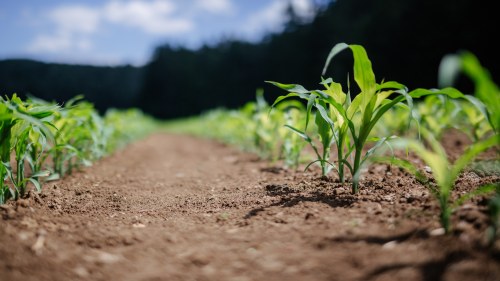The Potential of Regenerative Agriculture

Investing in regenerative agriculture opens a world of possibilities for the agricultural sector.
Regenerative agriculture is a form of agriculture that is quickly gaining traction in the agricultural and agribusiness sectors. It aims to meet the changing environment by creating resilient agricultural systems. It does so by focusing on soil health and practices, biodiversity, and community resilience. There is no consensus on the definition or purpose of regenerative agriculture – functionally, some view the term “regenerative” as a semantic rebrand for “sustainable” or “climate-smart.” Broadly, regenerative agriculture addresses the economic, environmental, and social goals important to farmers and society. Common practices encompassed by regenerative agriculture include cover cropping, minimizing tillage, rotational grazing, and installation of conservation buffers, and should be used together when feasible. The ultimate desired outcomes of regenerative agriculture practices are to build soil health, sequester carbon, improve the ecosystem (water and air quality, etc.), bolster biodiversity, support the socioeconomic “viability” of farms practicing regenerative agriculture, support community resilience, improve health and nutrition, and support farmers’ and farmworkers’ rights. The goals are to build, support, and bolster climate adaptation and mitigation strategies; improve socio-economic conditions of farmers, farmworkers, and community; and integrate the practices associated with regenerative agriculture.
The Political Economy of Regenerative Agriculture
Regenerative agriculture seeks to ensure that agricultural systems can not only survive but flourish in changing environments while supporting community resilience. While regenerative agricultural practices promote “socioeconomic viability,” regenerative agriculture to date has mostly focused on the “economic” portion of socioeconomic and too often neglects the social aspects that shape regenerative agriculture.
The political and economic forces that shape regenerative agriculture favor financially well-established legacy farmers. Regenerative agriculture practices are expensive and can take up to three years to be profitable. Even the most generous assistance packages focus on the uptake of regenerative agriculture practices and are insufficient to cover losses that typically occur in the initial years. Thus, farmers must have a financial buffer to maintain regenerative agriculture practices for at least three years. The financial risk is a deterrent for farmers to transition to regenerative agriculture, and that barrier serves to maintain the current production-focused agriculture system. The financial risk associated with regenerative agriculture supports existing socioeconomic stratification and tends not to favor small farming operations and newly established farms, especially those established by minority farmers. The incentive structures of most regenerative agriculture purport to support a narrative of “community resilience,” yet it fails to address systemic racism and environmental injustice. A clear example is the lack of acknowledgment of the Indigenous knowledge systems that regenerative agriculture relies on and the inaccessibility of regenerative agriculture to non-white farmers.
Foundations of Regenerative Agriculture Practices
The foundation of regenerative agriculture relies heavily on diverse knowledge systems, including Indigenous knowledge. However, the connections between regenerative agriculture and these knowledge systems are rarely acknowledged. Scholars who examine foodways and agricultural practices point out that regenerative agriculture must recognize the Indigenous knowledge it is built upon. 1 2 3 Engaging with the effects of settler colonialism and Indigenous land dispossession that facilitate large-scale industrial agriculture 4 is also essential. Land dispossession in America’s past has led to a lack of autonomy over land and agricultural practices in Indigenous communities. As a result, Indigenous communities experience disproportionately higher rates of food insecurity. The COVID-19 pandemic has exacerbated the food insecurity Indigenous communities experience. During the height of the COVID-19 pandemic, an estimated 56 percent of Indigenous households experienced some level of food insecurity. These trends in food security also occur with higher rates of cardiometabolic disorders and diseases, such as diabetes and obesity, in Indigenous communities. Community-driven food sovereignty initiatives work towards building food availability, stability, and access in communities while bolstering community building and reclaiming traditional food systems and foodways. 5 Collaborating with these efforts could be a step towards building better and more ethical agriculture systems.
Such a collaboration would also be in step with government initiatives. The US Department of Agriculture instituted the Indigenous Food Sovereignty Initiative in 2021, which partners with Indigenous farmers and chefs to “rework and recreate the federal food and agricultural programs from an indigenous perspective.” This initiative highlights the importance of working at a local scale. To be successful and engage with multiple communities, regenerative agriculture should also work at the community level by creating and fostering farmer-to-farmer networks and connecting farmers and their communities.
Potential of Regenerative Agriculture
To focus on community-level issues and connections, regenerative agriculture should address how socioeconomic inequalities impact small-scale farming and under-represented farmers’ abilities to engage in regenerative agriculture. To do so, institutions that invest in regenerative agriculture should focus on small-scale farmers' access to resources (financial, technical assistance, burdens of time, geographic, environmental, etc.). These investments should be targeted at the community level – addressing specific environments and community resources and needs. Studies have found that knowledge at the local and community level supports more effective regenerative practices and outcomes. 6 As such, investments at the local level provide essential support for local farmers and communities, and community resilience is vital to the practices and outcomes of regenerative agriculture.
Fundamentally, the effects of current structures are not going away for agronomy and agriculture, but regenerative agriculture systems can push back against maximizing agricultural production as farmers’ sole objective. In practice, this can be achieved by working with small-scale and non-white, and Indigenous communities and farmers. Collaborative partnerships with these farmers will require financial, material, educational, and labor resources, information distribution opportunities like social media, field days, and community investments. Resources should be provided to assist farmers in ensuring they are financially sustainable over the long term. Access to resources should be incorporated into the farming operation itself and the community the farm is situated in. Moreover, it should also include actively addressing the climate crisis and working to meet and anticipate localized environmental and ecological conditions.
Can regenerative agriculture meet its goals? Maybe. However, there should first be a critical evaluation of how we define regenerative agriculture and who it benefits. Institutions, farmers, communities, and community stakeholders will need to agree on what regenerative agriculture means, its goals, and how they will meet them in practical and actionable ways. The current definition of regenerative agriculture, the one laid out earlier, is quite elaborate. To be successful, the practice of regenerative agriculture should include work at the community level, work in collaborative partnerships with Indigenous and non-white farmers, support for small-scale farming and food sovereignty movements, support for farmer-to-farmer networks, and investment in farming communities.
- 1El-Sayed, S., & Cloutier, S. (2022). Weaving disciplines to conceptualize a regenerative food system. Journal of Agriculture, Food Systems, and Community Development, 11(2), Article 2. https://doi.org/10.5304/jafscd.2022.112.003
- 2Gordon, E., Davila, F., & Riedy, C. (2022). Transforming landscapes and mindscapes through regenerative agriculture. Agriculture and Human Values, 39(2), 809–826. https://doi.org/10.1007/s10460-021-10276-0
- 3Gordon, E., Davila, F., & Riedy, C. (2023). Regenerative agriculture: A potentially transformative storyline shared by nine discourses. Sustainability Science. https://doi.org/10.1007/s11625-022-01281-1
- 4Kepkiewicz, L., & Dale, B. (2019). Keeping ‘our’ land: Property, agriculture and tensions between Indigenous and settler visions of food sovereignty in Canada. The Journal of Peasant Studies, 46(5), 983–1002. https://doi.org/10.1080/03066150.2018.1439929
- 5Gordon, K., Xavier, A. L., & Neufeld, H. T. (2018). Healthy Roots: Building capacity through shared stories rooted in Haudenosaunee knowledge to promote Indigenous foodways and well-being. Canadian Food Studies / La Revue Canadienne Des Études Sur l’alimentation, 5(2), Article 2. https://doi.org/10.15353/cfs-rcea.v5i2.210
- 6O’Donoghue, T., Minasny, B., & McBratney, A. (2022). Regenerative Agriculture and Its Potential to Improve Farmscape Function. Sustainability, 14(10), Article 10. https://doi.org/10.3390/su14105815

